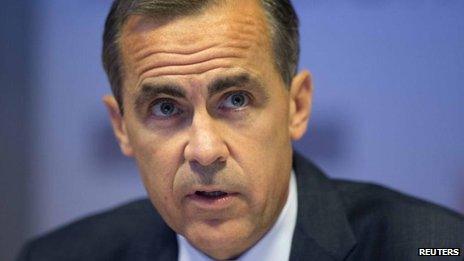The Bank's new guidance
- Published
- comments

Did the Bank of England loosen monetary policy today? Mark Carney would like you to think it has. He would also like you to think that it hasn't.
You might not think that is very helpful. But life is complicated right now for Britain's central bank. All that the Monetary Policy Committee (MPC) is really doing with its new "forward guidance" is sharing more of that complexity with all of us.
Put it another way: they have promised to make the policy trade-offs between growth and inflation more transparent. They have not promised to make those trade-offs go away.
You could see this tension running right through the new governor's big press conference. We were supposed to think that today's move would make the Bank's policy more "effective". But we weren't supposed to conclude that policy had actually changed.
Mr Carney said, in terms, that there has not been a change in the way the Bank would react to improving news about the economy. It was not, to use the jargon, a change in the MPC's "reaction function". The MPC was simply choosing to make that reaction function more explicit.
So, the Bank can have its cake. And it can eat it too.
What does it all mean in practice? That is the question that City economists and investors are now rushing to answer, as they examine the details of the new guidance.
The fairly modest market reaction so far suggests that this is not being seen as a major loosening in future policy - or at least, not any larger than people in the City were already expecting. If anything, the rise in the value of the pound suggests rather the opposite.
You could argue that the details of the guidance mean a slight loosening in the formal approach to the inflation target. After all, the Bank previously targeted 2% inflation 18-36 months ahead.
By contrast, the "knock-out" provision says they won't consider raising the Bank rate, with a 7% plus unemployment rate, unless inflation 18-24 months ahead has a more than 50% chance of being over 2.5%.
Perhaps. But if there is a loosening, it's pretty small. You might also argue, looking at the Bank's recent record on inflation, that the MPC actually loosened its approach to the target quite a while ago. This just makes it explicit.
What's most interesting to me, in today's guidance, is the fine print.
I suggested last week that the "knock-out" provisions about inflation would be the most important. If anything, the three knock-outs are a bit stronger than I might have expected, and suggest that the "hawks" on the MPC needed quite a lot of reassurance to sign up.
Looking at the Bank's latest forecasts, it wouldn't take much for the inflation forecast 18-24 months from now to go above 2.5%.
It's perfectly possible that the 7% unemployment threshold will also be breached, well before 2016.
But, if productivity - output per head - recovers along with the economy, we might also see the unemployment rate stay above 7% well into 2017, even with quite strong growth in national output.
In that case, the MPC might have to raise the Bank rate, to meet the inflation target, well before their new unemployment test has been reached. Or it might not. It would all depend on what that rise in productivity was doing to the economy's long-term potential.
You might find all these "mights" and "might nots" rather unsatisfying. Not to say mealy-mouthed. But as Mark Carney said himself, part of the point of the guidance is to give the MPC more scope to keep policy loose, while these supply side uncertainties are resolved. (I went into this argument in greater depth a few weeks ago.)
To return to where I began: the Bank's new guidance makes the difficult trade-offs now facing the MPC more explicit. It does not make them go away.
If there was news from today's press conference it was this; the Bank of England's policy makers are not cracking out the champagne at the UK returning to its long-term average growth rate of roughly 2.5% a year. They want more, and they are going to try quite hard to get it.